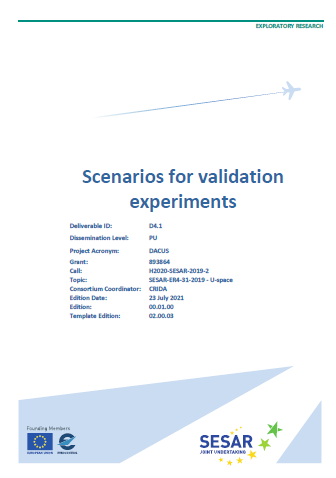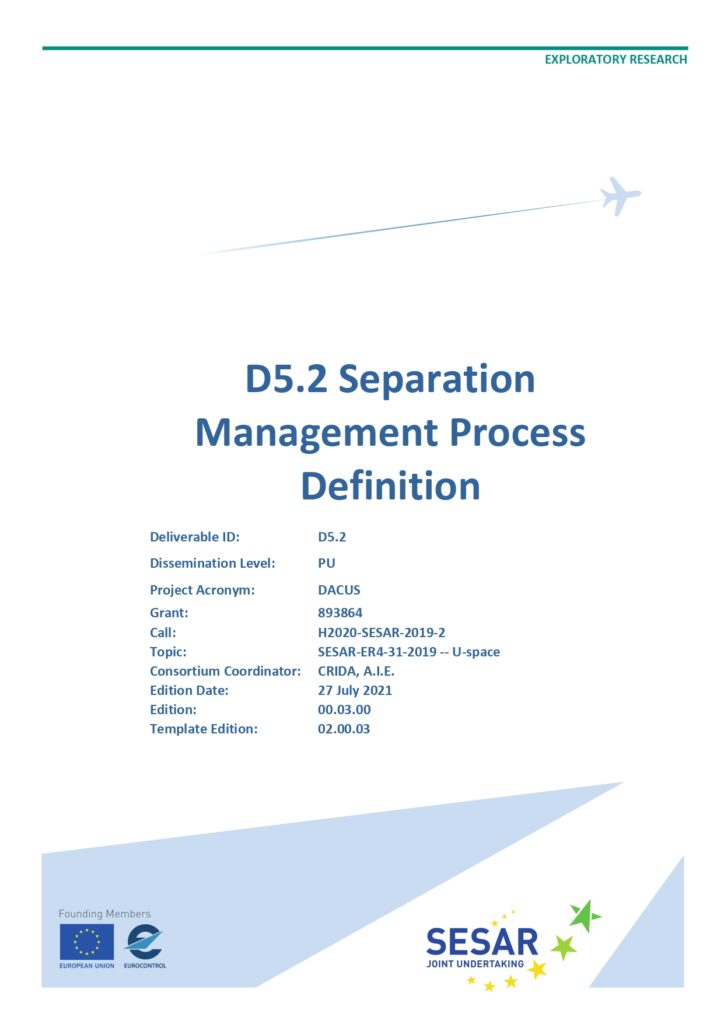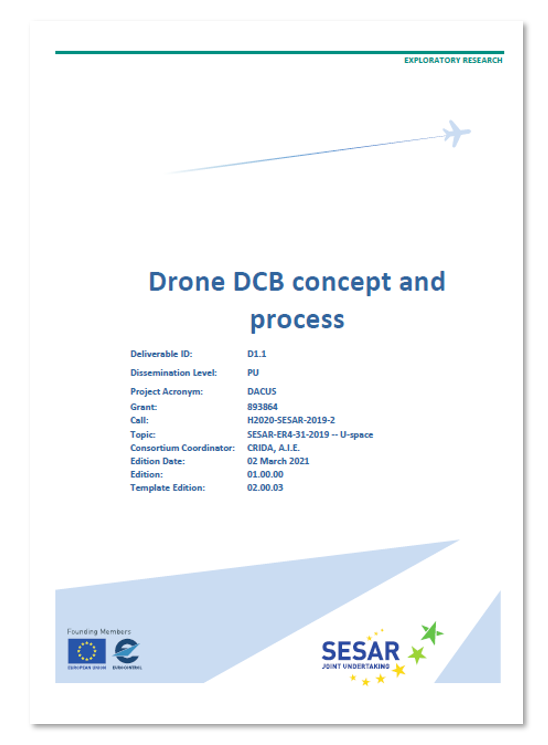downloads
Here you can find all published documents you might be interested in. For further information, please feel free to contact us and we will be glad to help you!
dacus Official Reports
To share our progress we publish the official project reports. In this section you can find all our public documents, sorted in the order of latest approval.
DACUS D6.3 Final Project Results Report (2022)
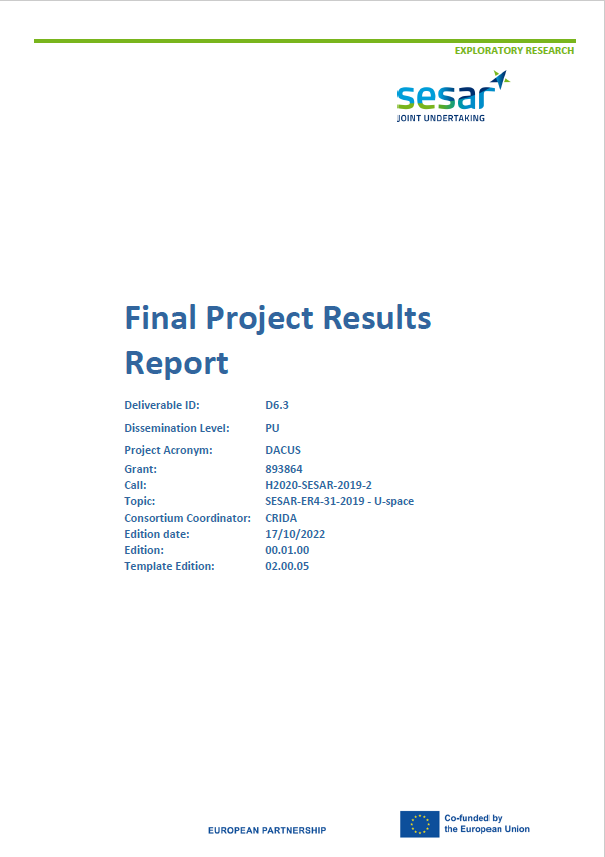
Authors:
- DACUS Consortium
DACUS D6.3 is the final report of the project. It details the work performed in the project as a whole, its technical deliverables and the key results that were obtained in relation to the services involved in the Demand & Capacity Balancing (DCB) process for U-space. This document focuses heavily on conclusions and recommendations that the project has gathered which are of relevance at U-space programme level.
DACUS D4.2 DACUS: Validation test results, KPI, and suitability metrics & report (2022)
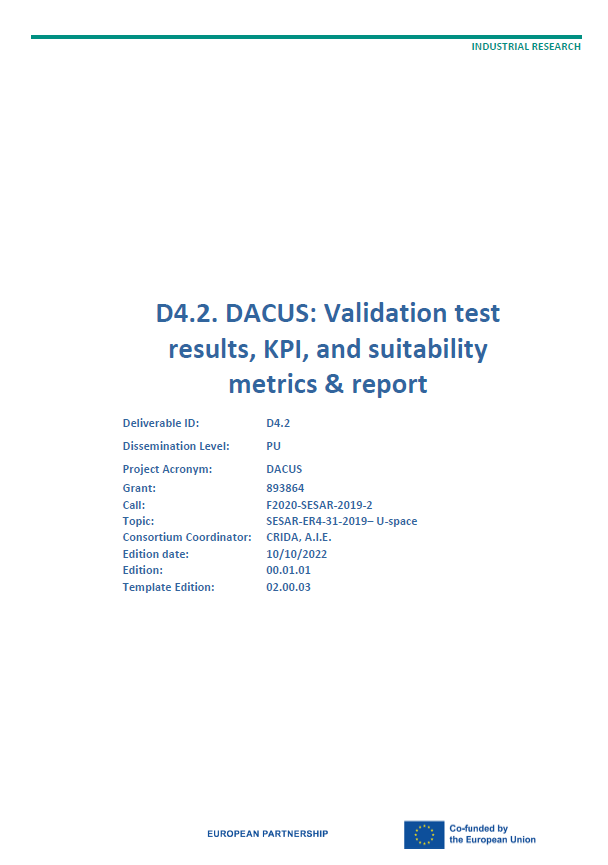
Authors:
- DACUS Consortium
This document presents the DACUS deliverable D4.2 Validation Report (VALR). It contains the results of the validation experiments that have been carried out by different project partners under the umbrella of the DACUS project.
Four validation experiments have been performed regarding the use of risk assessment and social impact prototypes that have been developed during the DACUS project operating at different stages of the Demand-Capacity Management (DCM) process for drone operations in the urban environment (U-Space), including strategic, pre-tactical and execution phases.
The results obtained are described in annexes of this report for each specific exercise, and then aggregated into global results, making reference to the research challenges identified the DACUS “drone DCB concept and process” (D1.1) and the DACUS “performance framework” (D5.3).
DACUS D3.4 Refined CNS Criteria (2022)

Authors:
- DACUS Consortium
The collision risk depends on the CNS infrastructure performances, so it is essential to identify the acceptable CNS performance requirements on a certain U-space volume, which will be more or less stringent, depending on the likelihood of fatalities due to UAS falling as a result of a
collision. The aim of this document is to define a method to review the CNS Requirements evaluated in the
previous DACUS Deliverables, based on the Collision Risk Model for the Strategic Phase (random trajectories) and to analyse to what extend they remain applicable for the Pre-Tactical Phase (real trajectories based on flight plans).
DACUS D1.2 Final optimized drone DCB (2022)
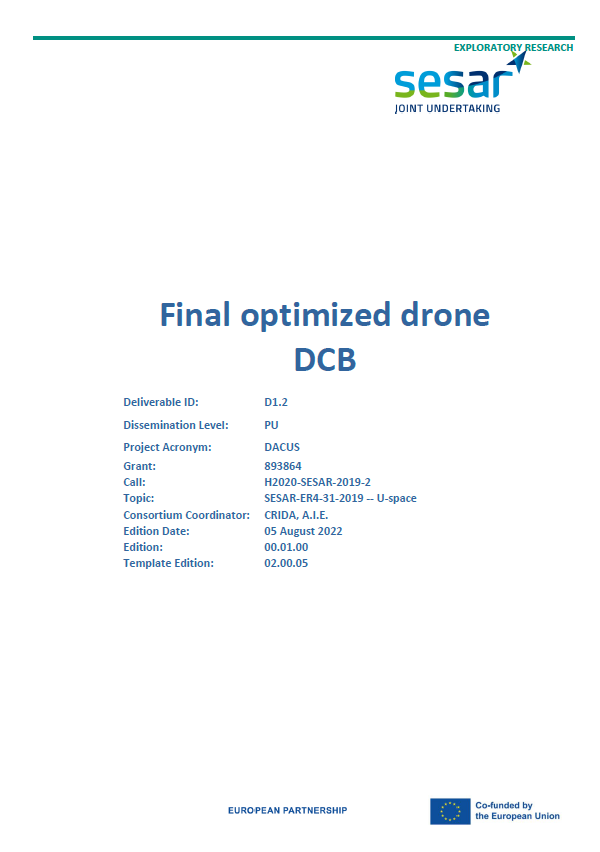
Authors:
- DACUS Consortium
This document describes the Concept of Operations for “Demand and Capacity Balancing” for drones within an urban environment. This process is supported by an extensive literature study and background information on the operational environment in which it takes place. Given the novel nature of drone operations in a civilian setting, several parallels of the proposed solution and the existing air traffic management environment are provided. Finally, the document serves as guidance material for the DACUS project and the implementation thereof within U-space.
DACUS D3.3 Dynamic separation minima (2021)

Authors:
- DACUS Consortium
This document introduces a method to set the Dynamic Separation Minima. For that, the steps followed to achieve it and the models developed to this end are presented as well as the results of the experiments carried out. The Dynamic Separation concept is part of the Separation Management Process, that plays an important impact in the Demand and Capacity Balance process that is being developed by DACUS.
DACUS D5.3 PERFORMANCE FRAMEWORK (2021)
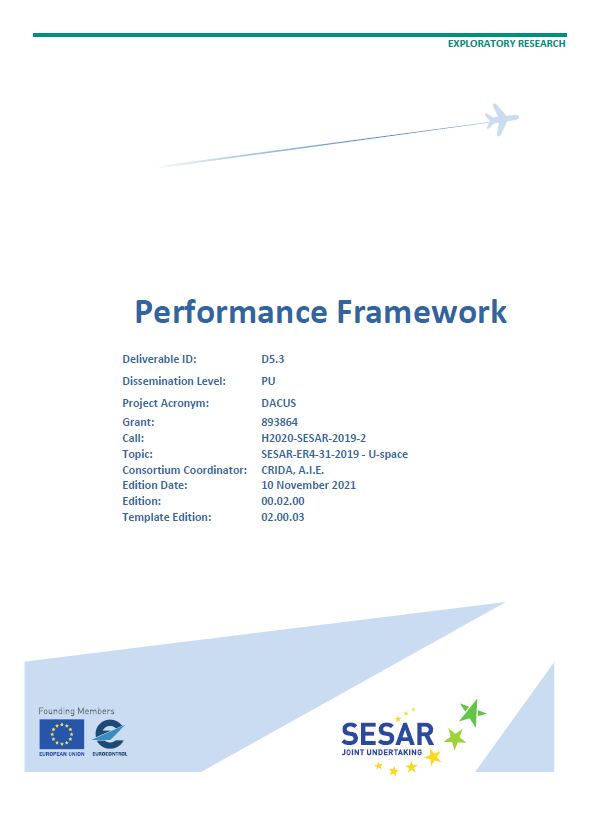
Authors:
- DACUS Consortium
This document proposes a new performance framework to support decision-making in U-space. The need of continuously monitoring the overall drone traffic and taking effective decisions to balance the demand and the capacity makes it necessary to define indicators that drive the DCB processes from the strategic up to the tactical phase. Relevant processes such as the implementation of adequate DCB measures or the selection of those drone operations that should be penalized if necessary, will rely on the new performance indicators proposed by DACUS in this document. In addition, the document identifies the challenges to calculate some of the indicators in the drones environment.
DACUS D4.1 Scenarios for validation experiments (2021)
This document details a set of operational scenarios which will allow the team to perform a series of validation experiments aimed at testing the suitability and performance of the various prototype algorithms under nominal and sub-nominal operating conditions, as well as to support the analysis of separation intelligence balance and refinement of CNS requirements linked to separation minima criteria.
The prototypes functions will address the generation of nominal and contingency-based probabilistic 4D trajectories, the calculation of foreseen demand based on AI, the calculation of demand prediction and uncertainty, the monitoring of collision and social risk indicators, and the identification of hot spots.
DACUS D5.2 Separation Management Process Definition (2021)
The aim of this document is to provide an approach to the offsetting of a Separation Management process within U-space, and in particular to highlight its link to the drone Demand and Capacity Balancing (DCB) process which is the core of DACUS project.
Separation Management is associated with maintaining the separation minima, and defining the conditions of application of the appropriate techniques (rules and responsibilities). An analysis has been done to identify the principles and assumptions necessary to define, in a theoretical level, this Separation Management process in U-space. The Time Horizon in which Separation Management is foreseen has been defined as a framework for setting these principles and assumptions, articulated around three main headings:
- Full Automation of Ground U-space Services;
- Simultaneous Operations under different Separation Schemes;
- Adaptive (performance-based) Application of Separation Schemes.
DACUS D5.1 Structures and Rules in Capacity Constrained (urban) Environments (2021)
DACUS D1.1 Drone DCB concept and process (2021)
This document describes the preliminary Concept of Operations for “Demand and Capacity Balancing” of drone operations within an urban environment. It provides a guideline for how U-space designated airspace shall be managed from the planning phase up until the execution of drone flights. This process is supported by an extensive literature study and background information on the operational environment in which it takes place. Given the novel nature of drone operations in a civilian setting, several parallels of the proposed solution and the existing air traffic management environment are provided. Finally, the document highlights several relevant research areas which the DACUS project will address.
Demand and Capacity Balancing is required where the amount of drone operations justifies the use of this service. Within the scope of the DACUS project, it has been identified that the urban environments would mainly be the location where high-density operations will take place in the near future. In order to lay down the environmental framework for a Concept of Operations for Demand and Capacity Balancing in U-space, an exhaustive description of the urban environments was necessary to well understand in which context the DCB service would be triggered and come into use.
This document provides a deep characterizations of the ground, low-level airspaces and expected CNS performances, so as a description of the legislative framework likely to constrain the operations, just to name a few.
dacus white papers
The DACUS official reports contain a wide set of solutions for the Demand and Capacity management of drone operations. To highlight the contributions of our research to the U-Space development, White Papers on key results obtained in the project are published in this section.
DACUS D5.1 social acceptance survey results (2021)
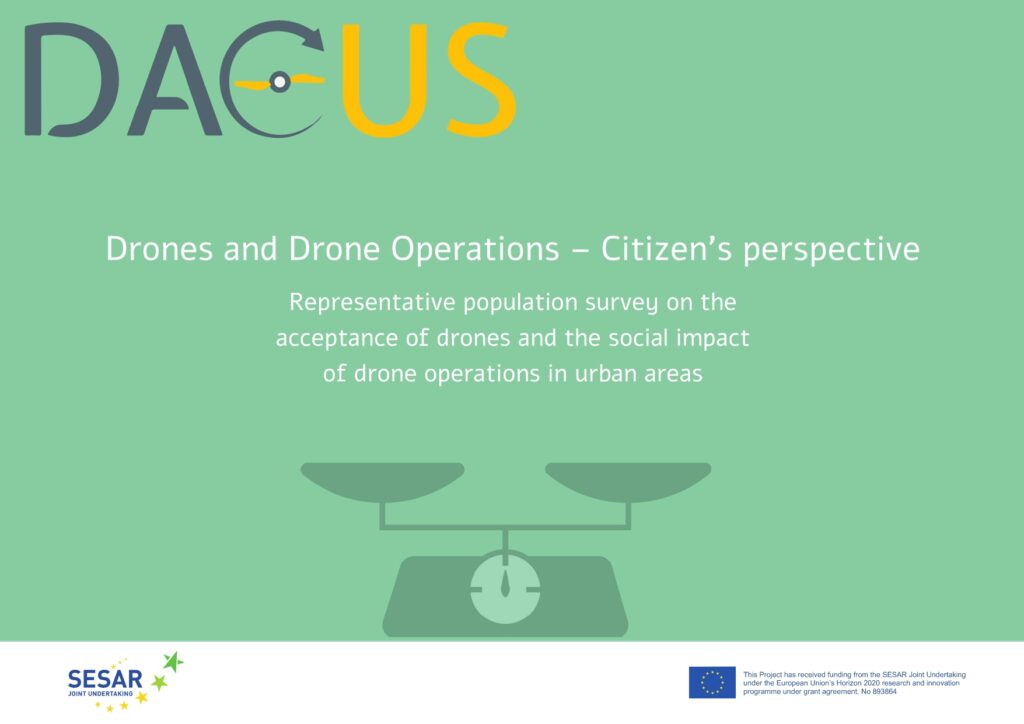
As the emergence of high-density operations in low-level airspace challenges traditional notions of safety, noise, and privacy, DACUS aims to incorporate society’s concerns and considerations into the distribution of drone traffic. To this end, a survey was conducted in 2020 to gain a better understanding of public perceptions of drone operations and the extent to which concerns could potentially slow unmanned flight operations over urban areas.
The following white paper summarizes the results of the survey.
Related scientific research publications
The concepts from the DACUS research are serving as a starting point to develop and evaluate different solutions for the DCB models and service functionalities. In this section you can find scientific publications that base their research on the DACUS concepts and explore these with innovative ideas and methods.
UAV Collision Risk as Part of U-space Demand and Capacity Balancing- SID 2021 paper

Authors:
- CRIDA
- INECO
The implementation of U-space will facilitate largescale operations of Unmanned Aerial Vehicles (UAVs) in urban environments. However, the capacity for permitting UAV flights in urban airspace is not unlimited. The DACUS project is developing a concept for balancing capacity and demand for U-space airspace, in line with operational requirements which are unique to the UAV domain. This paper focuses on exploring the role of collision risk between UAVs as part of this process. A collision risk model was developed and tested in a series of experiments as a means of identifying how many UAVs can operate in a given area without exceeding pre-defined risk thresholds. We present the methodology behind this model, and support our claims based on results gathered from some initial experiments. Results provide some initial estimations of airspace capacity values for urban environments, which will be further refined in future experiments.
White paper rule-based separation for dynamic airspace management
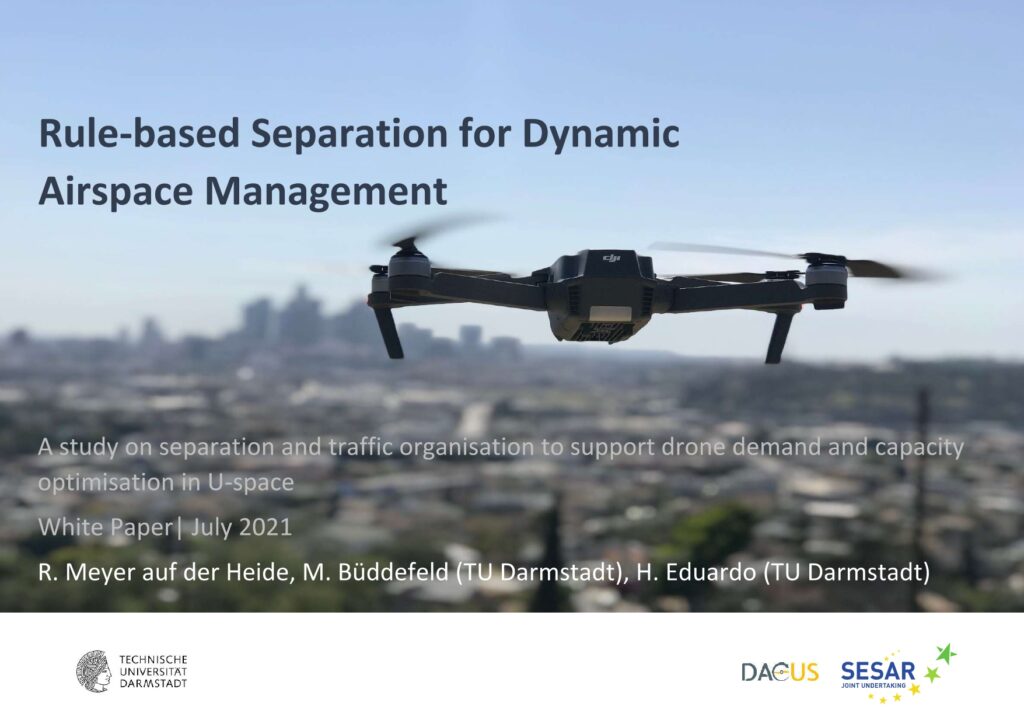
Authors:
- Ramón Meyer auf der Heide
- Technical University Darmstadt, a member of the DACUS Consortium
This White Paper presents the results of a Master’s thesis, which evaluates solutions for the traffic organisation of drones in support of dynamic airspace management, in order to reduce the number of conflicts through focused strategic separation. Considering related research activities and recognizing the ongoing regulatory development, multiple separation rules have been developed and compared. Finally, the implications of implementing these rules are discussed.
Towards a continuous demand and capacity balancing process for u-space - sid 2020 paper
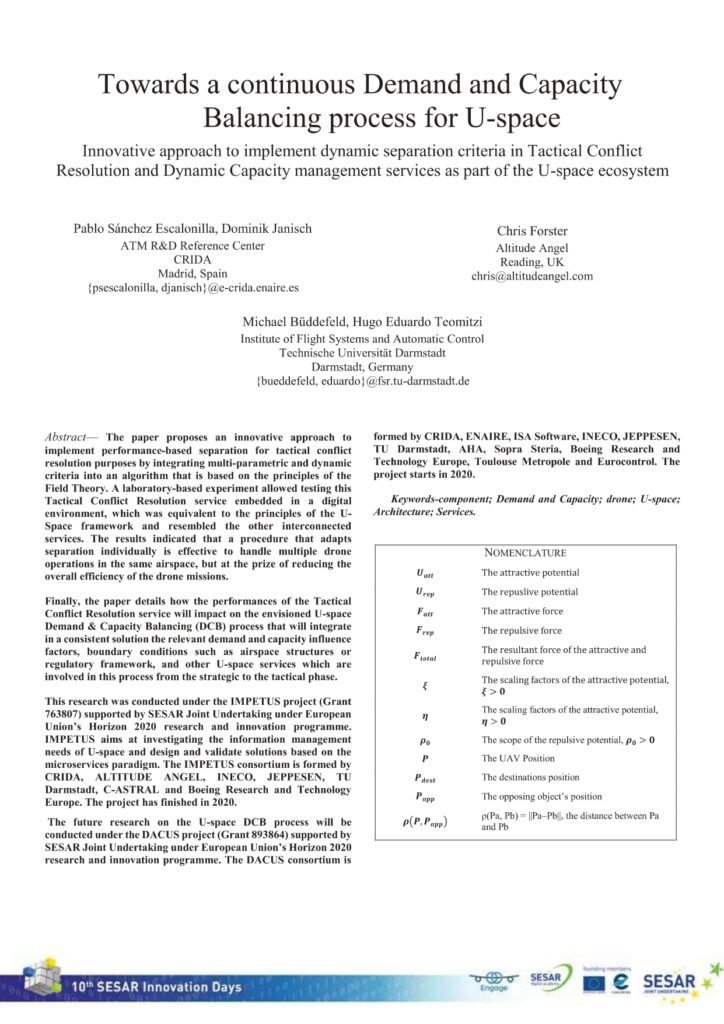
Authors:
- CRIDA, a member of the DACUS Consortium
- Technical University Darmstadt, a member of the DACUS Consortium
- Chris Forster, Altitude Angel
This paper proposes an innovative approach to implement performance-based separation for tactical conflict resolution purposes by integrating multi-parametric and dynamic criteria into an algorithm that is based on the principles of the Field Theory.
